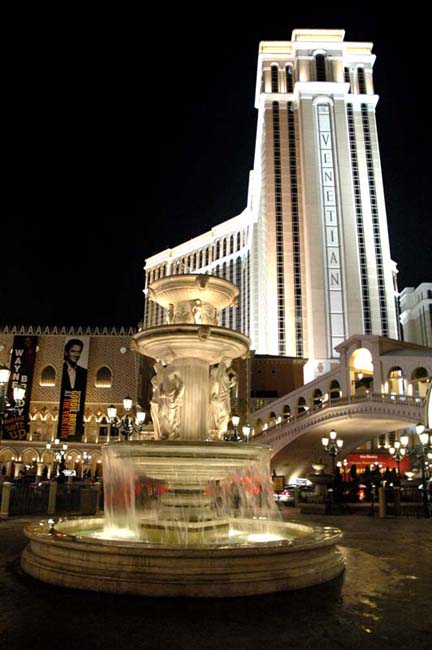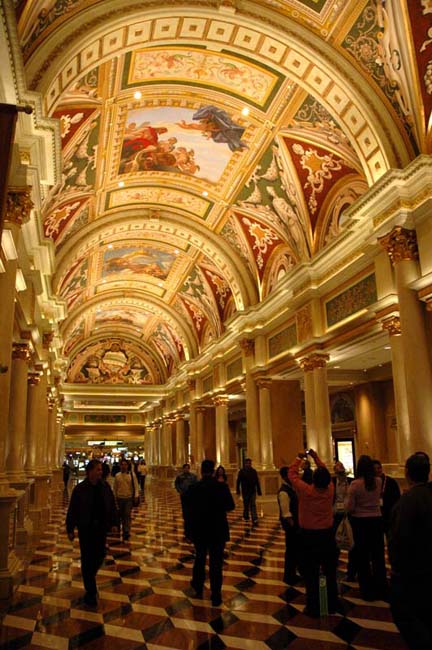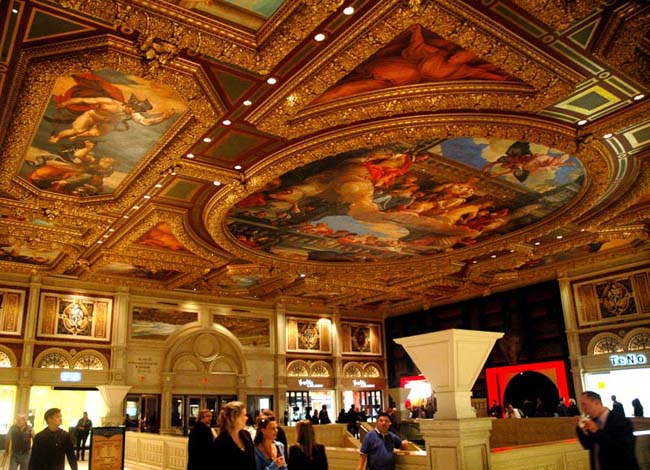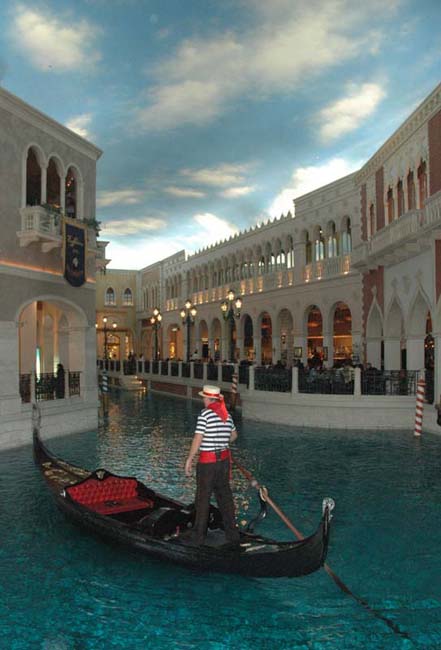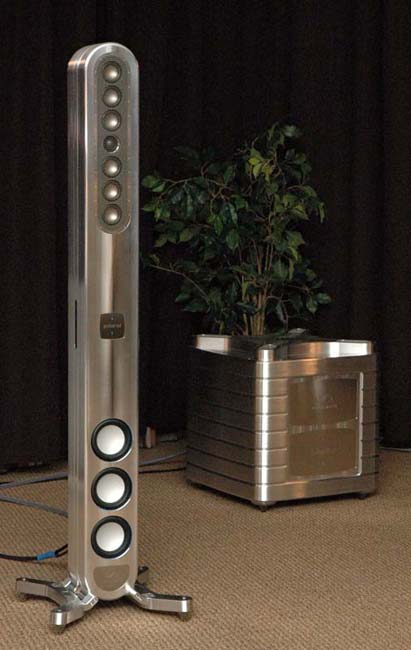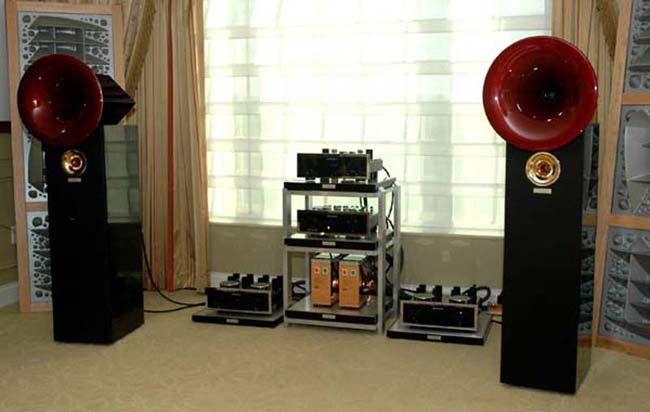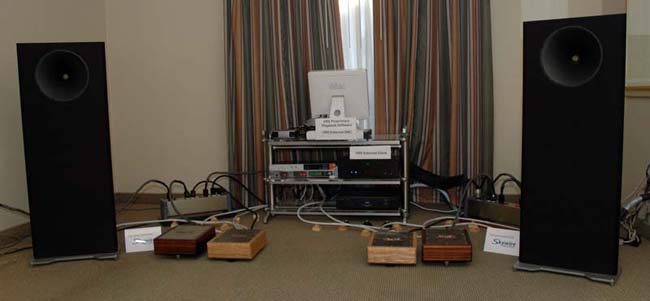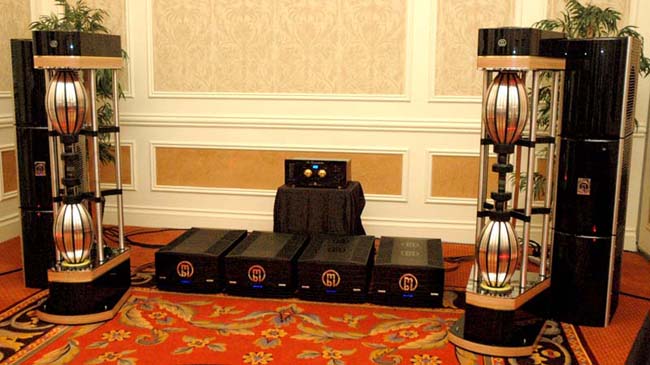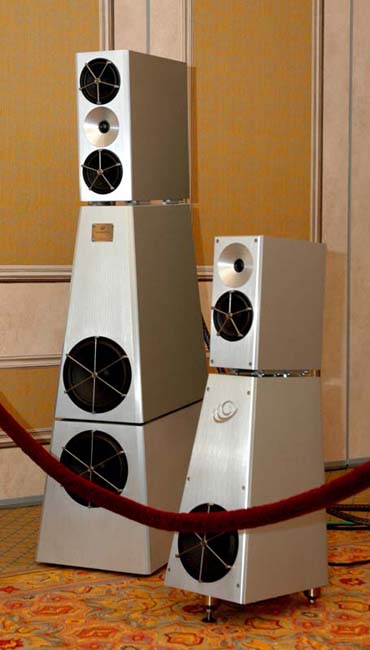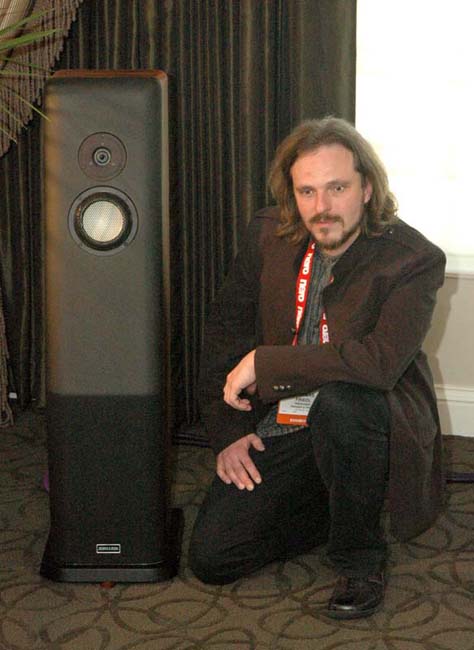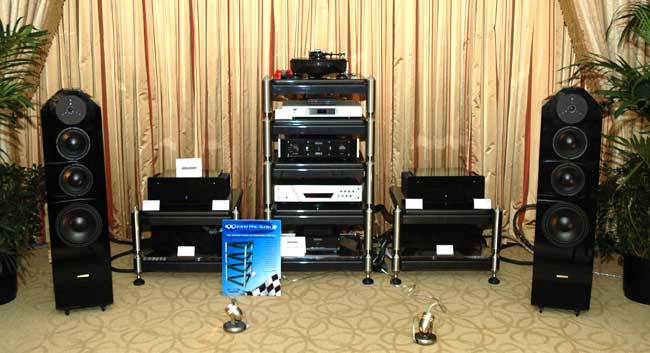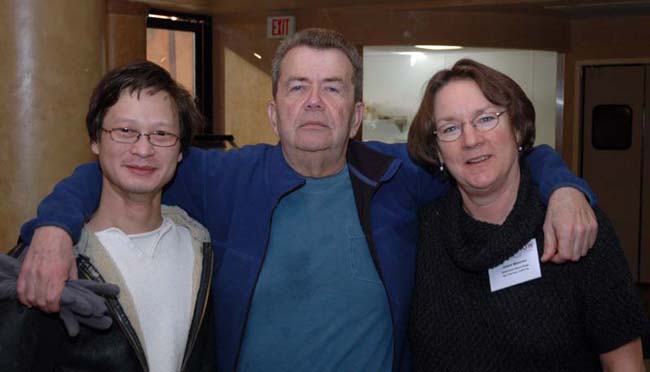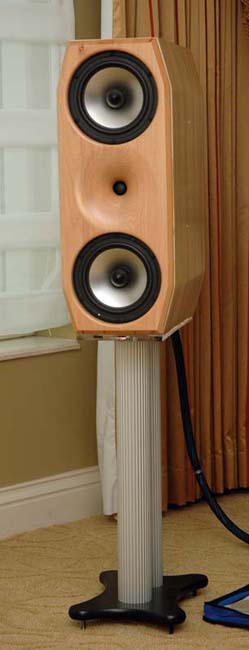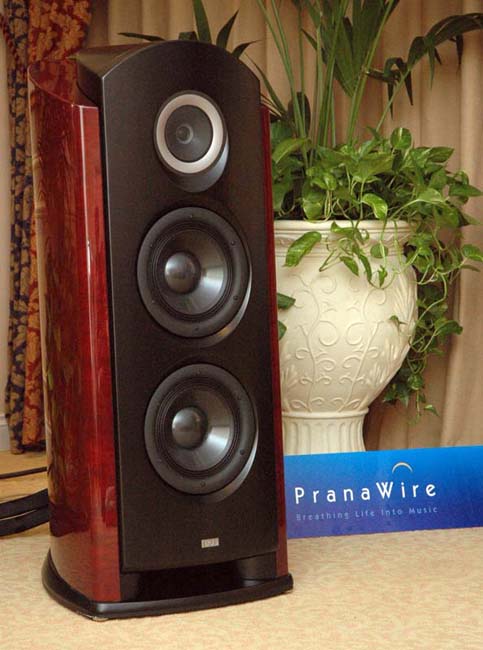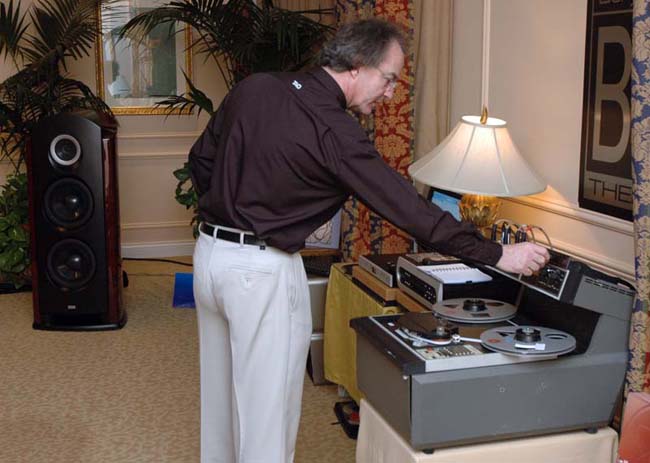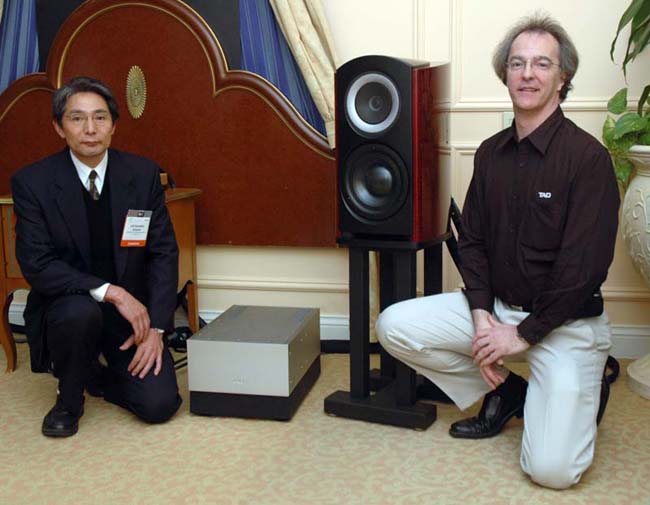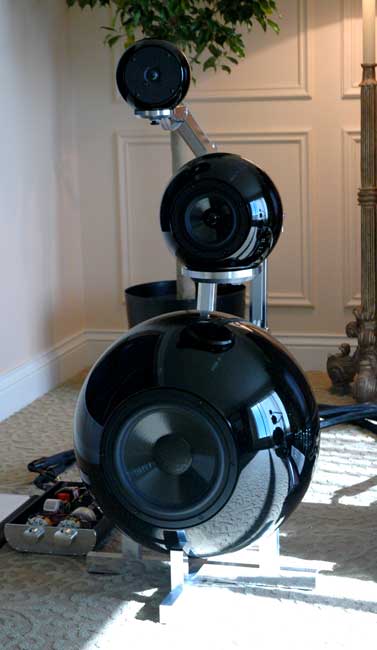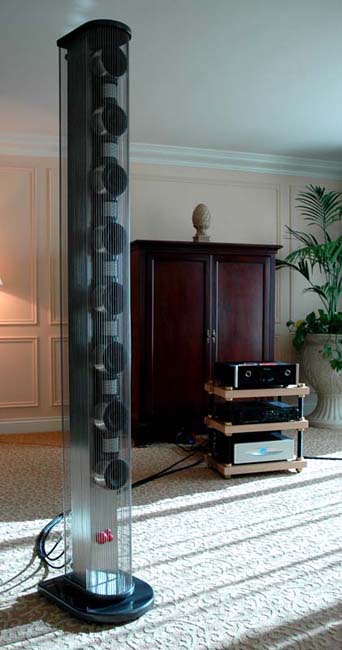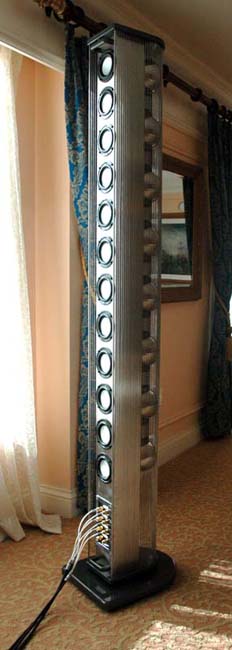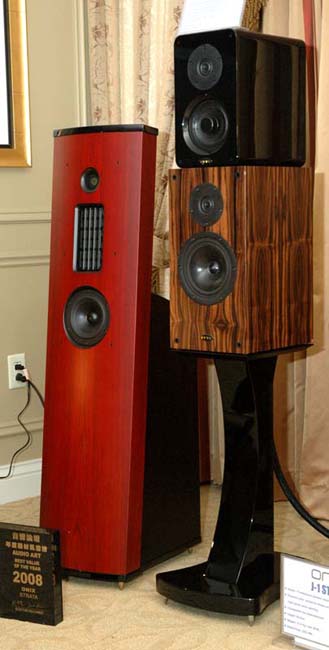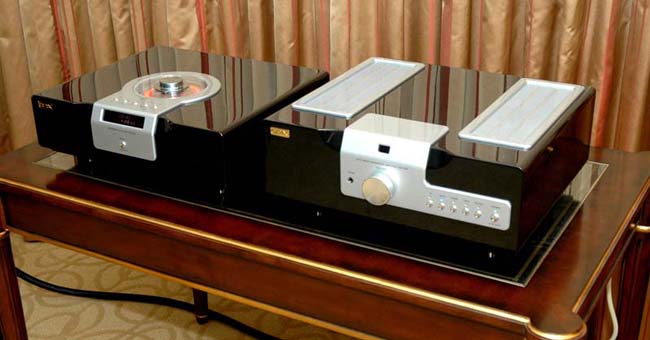|
You are reading the older HTML site Positive Feedback ISSUE january/february 2008
CES 2008 - Another One from the Road (or, 41
@ 52)
Prologue - in defense of tardiness While it was my desire to produce this report within two weeks of my return from this year's event, two projects at work conspired to eat up my time and prevent me from its accomplishment. As an IT Engineer at the University of Notre Dame, I was involved in two high-profile projects in January. The first, the development and deployment of a secure on-line store for the Recreation Sports division of the Athletics Department had a rollout date of January 24th. The second is an ongoing IT Security Audit of the same department. Consequently, I was not able to spend any earnest time producing this account until after the 24ths roll out of that major project. With that obligatory, whiney excuse out of the way, let the games begin.
A night view of the stately Venetian, with its ornate fountain, from Las Vegas Boulevard The Venetian The forty-first Consumer Electronics show was, from the fine audio exhibit perspective at least, considerably more successful than last years fortieth. Hosted for its second year by the opulently picturesque Venetian Resort, only a handful of "live" audio exhibits were located on the four enormously vast convention and meeting room floors of the conjoined Sands Convention Center, where there were so many blatant disappointments last year.
A view of the enormous mural covered arched hallway connecting the Venetian main entrance with the Casino The Venetian is an utterly charming, if not all-together convenient or straightforward, site to host the high-end audio portion of the annual industry show. My reasoning lies in that there are floors on the lower levels that do not permit anyone without a room key (i.e., a hotel guest), to access an elevator to the exhibit floors, this year on floors 28 and 29, with a handful of more luxurious exhibits on floors 34 and 35, without assistance.
Looking up after entering the main entrance, the ceiling is covered with Renaissance-style fresco's I've never been to the city of Venice, so I cannot say that the décor and lavish appearances are truly authentic. What I can attest to is that they are splendid and exceedingly effective. While I find Las Vegas in general to be an oasis of excess and conspicuous waste, there are parts of it that can be charming. The Venetian is one of those constituent parts. Among the most interesting sights the Venetian has to offer are the Canal Shops. As you traverse the stone walkways winding through the second floor past all the shops and boutiques, you have an inescapable feeling that you are actually walking outside under an open sky. Looking up while walking, the illusion becomes so real that it seems as though the clouds are even moving.
One of the Venetian's "synthetic" canals on the second floor, above the casino, with the faux open sky above The canals are populated with gondoliers who will serenade you while they take you on a gondola ride through the synthetic canal system on the second floor. That's right, I said the second floor. These shops and manufactured canals are above the casino floor. As much as I complain about Vegas' conspicuous consumption and overindulgence, I have to say that I relish going each year—for the company of those I only have opportunity to visit with at this event and the eateries. There are some remarkable restaurants in the city, and this year, I got to enjoy more than a few. Sunday evening found me at Bobby Flay's Mesa Grill in Caesar's Palace. In the company of Dave, Carol, and Peter Clark, Bob Hirsch (Passion for Audio, San Diego), and long time friend Alan Kafton (audioexcellenceaz Phoenix), I had the Blue Corn Pancake appetizer (barbecued duck in a blue tortilla, served with habanero chile, and drizzled with star anise sauce), followed by one of Bobby's renowned Black Angus New York Strips. To die for! Monday found me jones-ing for good burger. Having sadly learned that Hamburger Mary's (immediately next to the St. Tropez) was no more, I ended up at a 50's style dinner directly across Paradise Road from the Hard Rock Hotel and Casino. I enjoyed a huge burger and a plate of fries while enjoying the company of Dan Wright (ModWright), Frank Kraus (FLK Marketing), John Tabernacki (NSR Sonic Research), and a friend of Dan's whose name eludes me, While it wasn't Hamburger Mary's (sigh), it did the trick—and the company was great.
Tuesday morning's sunrise from the 19th floor of the Orleans looking south east toward the Luxor and Mandalay Bay Finding ourselves still in the Mirage at suppertime Tuesday after finishing up in the Penthouse suite of Philip O'Hanlon (On A Higher Note), Jim Merod and I decided to try a little place there called STACK. We were joined by friends Steve McCormack (SMc), and John Tabernacki (NSR Sonic Research). I had the Yellowtail Sashimi, but the conversation was hampered by the non-programmed (i.e., random play on an iPod), music selection and the overall VOLUME of the place. Not recommended. Wednesday I enjoyed the buffet voted "best Las Vegas in 2007" at the Planet Hollywood. Best of all was sharing time with Rich Hollis (long-time friend and engineer of Hollis Audio Labs) and his wife Susan. I used to spend a good deal of time in Rich's southern Maryland listening room. Rich built his house around his 10' by 16' by 26' "golden ratio" audio room. Lucky dog! I get to see him so infrequently that it is always a true pleasure when we take time to catch up. It seems to have become tradition to eat at Fiamma Trattoria & Bar in the MGM Grand on my last night in town, and this year was no exception. Joined again by the troika of Clarks, Bob Hirsch, Alan Kafton, and John Tabernacki, I enjoyed their signature rigatoni with sausage, Prosciutto Bolognese, and Parmigiano Fonduta. We also had an exquisite red wine with our meal. Overall, dinning in Vegas tends to be one of my more extravagant treats to myself annually. Good… As with most shows, there were the requisite handful of systems that came very close, but stopped somewhat short of perfection; systems I had hoped to find more rewarding than they actually were. These systems are still on my "watch" list, but were just not quite able to warrant a full recommendation—yet.
The $99,990 Sonicweld Pulserod system—looking ever so cool A system with great promise, one that just isn't quite realized, was the latest system from Josh Heiner. The Sonicweld Pulserod system starts with an ultra-compact active loudspeaker system. Housing thirteen drivers, each tower also employs three, 200W switching amplifier modules. The use of two independent power supplies per unit is intended to allow the midrange and treble amplifiers to respond independently, even when there is a need for high current delivery to the midbass drivers. The Pulserod system is designed to function exclusively with the DEQX PDC system, one that requires only an analog or digital source for operation. Sonicweld further modifies the supplied DEQX unit, including a complete power supply replacement and other signal path modifications. Price with two Subpulse subwoofers is $99,990. While I recall being quite taken with the introduction of Josh's $30,000 original Sonicweld monitor (circa. 1998), the Pulserod system was decidedly to the dry and uninvolving side of natural, even if it was remarkable dynamic, self-contained and attractive.
Acapella High Violon Mk 4 loudspeakers ($59,000), driven by Einstein gear ($42,000) This Acapella/Einstein combination always seems to mesh with tonal color and dynamics. The only caveat is the soundstage. If you can clearly picture a realistically spaced and sized soundstage as watching a film on a life-sized big screen, this combination, in every pairing that I've yet heard, recreates it much LARGER, as though you are witnessing the real thing reproduced on an IMAX screen. Longtime colleague, Constantine Soo, assures me that he has heard this pairing sound very natural. I will have to keep searching, as I have to admit to liking most everything else about this combination of gear.
VRS Audio Solutions teamed with audioexcellence az to show one very possible future of digital music servers VRS Audio Solutions, the brainchild of Vincent R. Sanders, shared a room at the Alexis Park with Alan Kafton of audioexellence az. Vincent has developed a particular approach to digital playback that relies on a computer's hard drive as a source, rather than an optical drive, and make use of digital equipment from the pro, rather than the audiophile, world. This room's front end was comprised of a pair of $1300 1.83 GHz Intel Core Duo based iMacs, Vincent's custom clock and AD/DA, his customized playback software (price to be determined), and a $7495 piece of pro gear, the Dolby® Laboratories Lake® Processor. The Dolby® Lake® Processor is a digital signal processing synthesis of hardware and software typically used to supply advanced loudspeaker management and equalization functionality. The system provides sound engineers the control and flexibility required to focus on the audio quality for tour sound, fixed arena or stadium installations, and studio applications. The processor provides remarkable control and flexibility of complex speaker systems throughout setup as well as live events, improving the sound of the system so audiences have a better experience. It is a critical part of the audio signal chain for live concerts in arenas and stadiums. This unique digital signal was fed to the $5995/pr Red Dragon Leviathan amplifiers, which in turn handed off to the astonishingly affordable $2995 Emerald Physics CS2 speakers. Skywire Audio provided the balanced interconnects, digital interconnects and speaker cables. Power cables were the all from PranaWire, the Kensho, Samadhi, and Maha Samadhi. Power conditioning was Alan's superlative WorldPower Power Wing.
While I admit that this system served up an
almost unparalleled dose of detail and microdynamic resolution, overall,
the sound was a bit too far to the lean and dry side of natural for my
tastes. Where I can easily see this being an exquisite tool for
reviewing and/or mastering, I just didn't find it to be a system that I
could live with. Granted, it is still evolving, so it really does
deserve your attention. In this section, I will be listing rooms that really stood out to me, ones that were clearly superior to the "run of the mill" fine audio gear. Starting with the bigger rooms of the Sands Convention Center space, there were two rooms that really stood out for me.
All mbl, mighty musical As they have at virtually every showing I've ever had the opportunity to witness, the mbl system sounded big, bold, vivid, and alive. I guess that there is just something about sticking hundreds of thousands of dollars of mbl gear together with just the right touch. I would very much like an opportunity to experience some of their products more closely.
The $90,000 YG Acoustics Anat Reference and new $38,000 Kipod YG Acoustics was also in one of the bigger rooms on the Sands Convention Center area. I admit to being taken by their clean, sleek, design and visceral presentation. Yet I have to add that the YG Acoustics' marketing team has some serious cojones. They bill the $90,000 Anat Reference as "The best speaker on earth—period." However, YG Acoustics President, Yoav Geva, was just as proud of his new $38,000 Kipod on display, which was introduced just this past summer.
Designer Andreas Friedl crouching beside the unbelievably natural sounding Trenner & Friedl Miles Loudspeaker Moving to rooms in the Venetian towers, one of the first rooms to really stand out by nature of its song-making ability was Bob Clarks's (Profundo) room which was undeniably natural sounding and highly involving. The analog source was a Basis Audio 2800, with Synchro-Wave power supply and Calibrator base, and employing the Basis Vector model 4 tonearm, (roughly $22,000 as configured) fitted with the $5000 Transfiguration Orpheus cartridge. The $22,000 Viva Audio Linea F preamplifier (with phono stage) fed the $24,900 Viva Verona Tre monoblock amps, which in turn drove the $27,000 Trenner & Friedl Miles loudspeakers, all using Basis speaker cables. All electronics used Basis power cords as well. Listening to some of Jim Merod's "private stash" of his own unpublished recordings was downright captivating in this room. More on this topic later. This empirical event, combined with Jim's experience with the less costly Viva Audio Solista integrated amplifier and Trenner & Friedl's Ella loudspeakers, have me dying for some real time in front of this combination of products.
Grand Prix Audio, SMC Audio, Eggleston and STEALTH cables teamed up to bring some life to both vinyl and optical disc Early Sunday evening, I stopped at a low traffic area of the Venetian (just inside the third floor elevator lobby) as it was a quite local. I wanted to be able to hear my wife while on a mobile phone call. As I was just finishing up our conversation, the three amigos of 30-212, Alvin Lloyd (Grand Prix Audio), Steve McCormack (SMc Audio) and Serguei Timachev (STEALTH cables), came laughing 'round the corner and walked directly across my path. Since I typically go out of my way to see any one of these three cats, the treat was all mine. Moreover, they offered to take me on up to their room, even at that late hour, for a private demo. Sources were alternately the $19,500 Grand Prix Audio Monaco Turntable, using a $4300 Graham Phantom B-44 arm, fitted with either the $5000 Transfiguration Orpheus or the $5500 Dynavector XV-1S, (a cart that was near ubiquitous at last year's event) or the McCormack UDP-1 universal disc player. Preamplification was conducted by Steve McCormack's latest brainchild, the stirringly musical $6800 SMc Audio VRE-1 Line source, assisted by the $2900 Ayre P5 phono stage. Power was generated by a pair of Steve's as-yet-unnamed custom $5000 SMc Monoblocks. The speakers were the $12,900 EgglestonWorks "The Nine," and all cabling was from STEALTH, including Swift Power Cords, Metacarbon interconnects and Dream Petite speaker cables. As would be expected, everything rested on Grand Prix Audio Monaco Modular Isolation systems ($6625, 5 shelf component system—$1650, amplifier system) with the full out treatment of Apex footers, including Silicon Nitride balls ($772) and Formula shelves ($1100). The total ticket on this system was just over $125,000, but man, did it WORK! I again marveled at the incredible performance of the GPA Monaco turntable. I have only heard a handful of tables that can even begin to compete with, let alone match, its overall authority, tonal truthfulness, and pitch accuracy. Perhaps it was the paring with Steve's new VRE-1 pre and custom amps, or maybe that, combined with the inherent naturalness and ease of Serguei's Metacarbon interconnects, I can't say with any certainty. But the overall smoothness and balance of the system this year seemed to easily exceed my memory of last year's only slightly less costly and marginally similar system. Sweet! Though I said it last year, I feel the accomplishment of "The Nine," handily bests EgglestonWorks last approximately $13,000 entrant, the Rossa. Overall, it offers more coherence, is more tonally natural, and renders more faithful bass than the elder Rossa was ever able to achieve.
Dung Tri Mai, Tri-Planar tonearms, Harry Pearson, the venerate hp of the Absolute Sound, and Janice Mancuso, of Reference Recordings One of the more interesting surprises I had this year was walking into the Nuforce room and hearing their new S-9 loudspeaker. Had I walked into this room with a blindfold, I would have sworn that this speaker was MUCH larger than it actually was. I was treated to a very full range, visceral, and lifelike rendition of the Stan Getz disc, Bossas and Ballads: The Lost Sessions that was spinning in the optical player courtesy of another show attendee. Very nice. I have inquired about a review…
Nuforce's exciting new $5000 S-9 loudspeaker Pioneer's High-End division, Technical Audio Devices, or TAD, showed their flagship $60,000 Reference One loudspeaker with a host of sources. Every year, Andrew Jones has a store of high-resolution digital files, most of which are to die for. This year, he added the use of an open reel machine employing a number of 15 IPS, half track stereo master "clones" made by the Tape Project.
The outstanding flagship of Pioneer's Technical Audio Device's division, the $60,000 TAD Reference One Duplicating original master tapes from some of the worlds greatest record sessions, they are selling essentially one-off master recordings, allowing the discriminating music lover the chance to experience superlative master tape sound at home. While quite pricy ($300 per recording), there are volume discounts ($200 each title) for orders of 8 recordings or more.
Andrew Jones, TAD, cues up an analog tape from "The Tape Project" to show off the $60,000 TAD Reverence One Loudspeaker This is very exciting news, and the sound was remarkable. So remarkable in fact, that a fair number number of exhibitors (including Philip O'Hanlon's On a Higher Note suite at the Mirage, Dan Meinwald of E.A.R., and the Kubala-Sosna gang) used these remarkable tapes as source material to really grab show attendees ears. Using Ayre Acoustics MX-R amplifiers and all PranaWire cabling, this suite on the 34th floor was a champion at tonal shading, extension, and dynamic expressiveness. After seeing and hearing the Reference One with those Tape Project master tape copies, Andrew said he had something of a treat for us. He then escorted a small group of us into a second anteroom behind the larger listening area of the 34th floor suite. In this much smaller room, we were to witness two still prototypical products, the Compact Reference One monitor, and an as-yet-unnamed amplifier project.
From right to left, TAD engineer Katsuhiro Sasaki, the new as yet unnamed, unpriced TAD amplifier, the new Compact Reference One Monitor, and Director of Engineering, Andrew Jones Completed just days before Christmas this year, the Compact Reference One employed a driver array selected from drivers used in both the current Model One Reference and its predecessor. Like the Ref One, it is fabricated of 1"-thick MDF laminate layers with an aluminum rear panel. It employs the same concentric beryllium-dome tweeter/midrange driver as the Ref One, but uses the 8" midbass driver used in the older four-way Reference One project. Having recently been elevated from a stealth project to a fully supported division of Pioneer, TAD announced its next prototype—an unnamed, new, more efficient version of solid state Class-A, monoblock. Built on a cast-iron base with aluminum side and top panels, the amp will weigh over 150 pounds and develop 300 watts into 8 ohms. Sasaki-san was on hand to share the spotlight and the demonstration with Andrew. Playing a hi-rez digital copy of Aaron Copeland's "Fanfare for the Common Man," recorded by Keith Johnson's for Reference Recordings, proved to be every bit as engaging, dynamic, and powerful as the demonstration in the larger room with the Reference Ones. NO BULL. Both products are expected to be available by next winter.
One of the unique products this year, the $26,000 Proclaim DMT-100; a "snowman" of spheres
Dennis Had of Cary and Dan Herrington of Proclaim loudspeakers were
exhibiting together with very impressive results. Cary was displaying
their new 306 Professional CD/SACD player, while driving the new
Proclaim DMT-100s with Cary Audio's CAD 120 stereo amplifier. After a
short sidebar on sailing when I shared with Dennis (apparently an avid
sailor), that my sister had just bought a '66 Morgan 34, we got back to
some very good music.
Anthony Gallo's striking and stirring $18,000 5LS loudspeaker The back of the 78" tall, by 7" wide, by 11" deep column sports a dozen 4" woofer drivers, also in a vertical line array. The twelve 4" woofers are said to approximate the cone surface of a 15" subwoofer, but because of the size, offer speed and transparency that a large single driver simply could never match. A single inductor acts as a first order, 6dB/octave crossover at 80Hz for the woofer section, with the midrange and tweeter drivers running full-range. The 5LS offers the ability to bi- or tri-wire, or to bi- or tri-amp. Although capable of being driven by very powerful amplification (they are rated safe with 500 watts), the crossover-less design and reasonably high efficiency (90dB) allow potential owners to mate them comfortably with low-powered, high-performance amplifiers as well. Bass amplification for this event was provided by the new AGA Reference SA amplifier, which features volume, phase, and crossover adjustments, while the mid/tweeter units were fed from the Spectron Musician III. It was a very successful showing, fast, detailed, and spacious.
AV123s (Sound Art Company, Ltd.), speaker lineup, including the highly over-achieving $1995 Strata Mini (red), the $1500 Monitor One (wood), and the $800 Concerto 1. As always, I was curious to stop by and see what my old friend Mark Schifter is doing. Mark has continued to both set the standard and consistently astound me with an ever-growing line-up of affordable products, all sold at online at AV123. This year, alongside the Stoopid Good, sub $2k Strata Mini, he was introducing two small monitor sized products, the $800 Concerto-1 and the $1500 Monitor 1.
AV123 introduced the Onix XCD 50 $3600 Unidisc Player and the 150-wpc, $2600 XIA 150 integrated amplifier Along with the two new speaker products, a $3600 Unidisc Player, the Onix XCD 50, and the 150-wpc, $2600 XIA 150 integrated amplifier were introduced. Given the way things ALWAYS sound there, I was not surprised. But, one of the best pieces of news I learned from Mark was that the brand new $6000 LS-9 speaker was almost ready to ship. I can't wait. I'm hoping that mark will send me a set to review.
|

